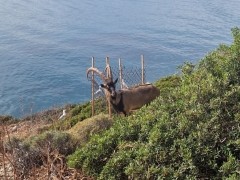Goat kri-kri - Crete
Cretan goat without oar

One of the typical features of the Greek island of Crete is the Cretan goat, or the "kri-kri" goat, as it is called by the locals. Several steps have been taken in recent decades to increase the numbers of this endangered species. It can be found nowhere else in the world but on the island of Crete.
The Kri-Kri goat (Capra aegagrus cretica), also known as the Cretan goat or "agrimi", is endemic to the island of Crete. This means that it is found nowhere else in the world but on the island of Crete and the three nearby islands of Dia, Thodorou and Agii Pantes. It was formerly considered a subspecies of wild goat, but nowadays the prevailing opinion is that it is a subspecies of the oarless goat. Some guidebooks also state that it is the largest wild mammal in Crete.
The Kri-Kri goat is larger than the common domestic goat, growing to an average length of 1.3 metres and has a light brown coat. The identifying feature of the Kri-Kri goat is the dark stripe on its back and its relatively long, backward curved horns. It can jump great distances and move deftly over very steep rocks. In the wild, it is a shy species that avoids humans and primarily rests during the day.
The 'agrimi' goat was probably introduced to Crete during the Minoan period and soon became an important species. By the 1960s, however, its population size had fallen below the critical threshold of 200 individuals. During the German occupation during the Second World War, it became the game of partisans hiding in the mountains. This was one of the reasons why the Samaria Gorge became a national park in 1962. The area of the gorge reaches up to the White Mountains and hosts other endemic animal species and is now protected as a UNESCO reserve. Currently, the goat population numbers about 2,000 individuals and is therefore still vulnerable. It is threatened mainly by hunters (hunting of Kri-Kri goats is strictly forbidden) and by interbreeding with domestic goats, which are also abundant in Crete.
As a symbol of the island of Crete, the Kri-Kri goat is often depicted on various souvenirs, but it is also found on historical objects. The motif of the kri-kri goat has been found on ancient vases, coins and carved into stones and masonry, proving that the animal was held in high esteem in ancient times.
Did you visit this place and do you have some additional informations, interessting observation or photos?
